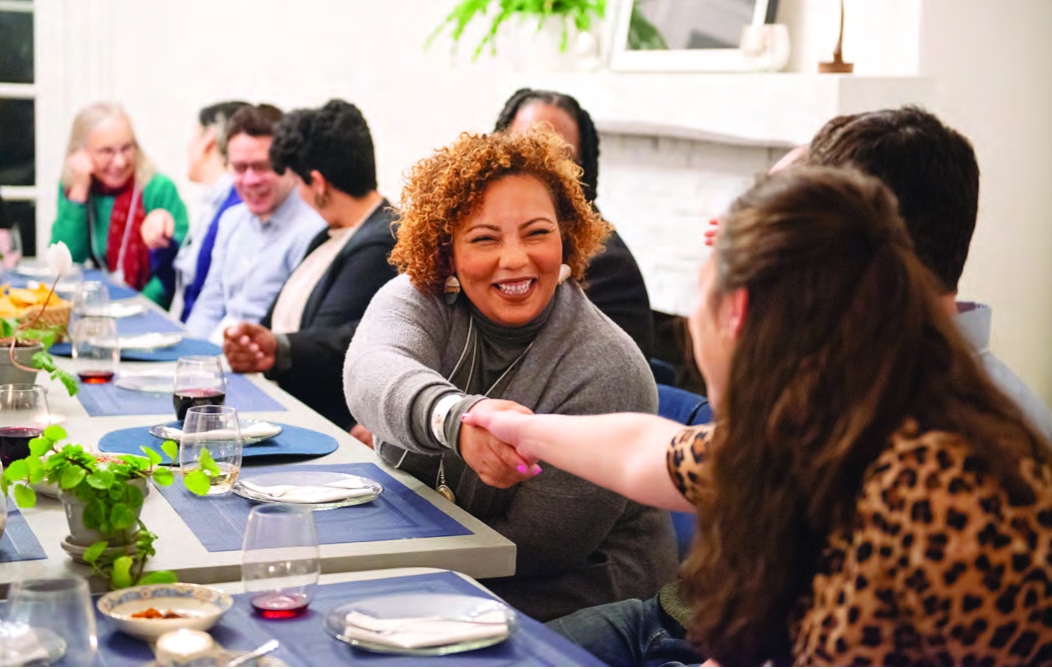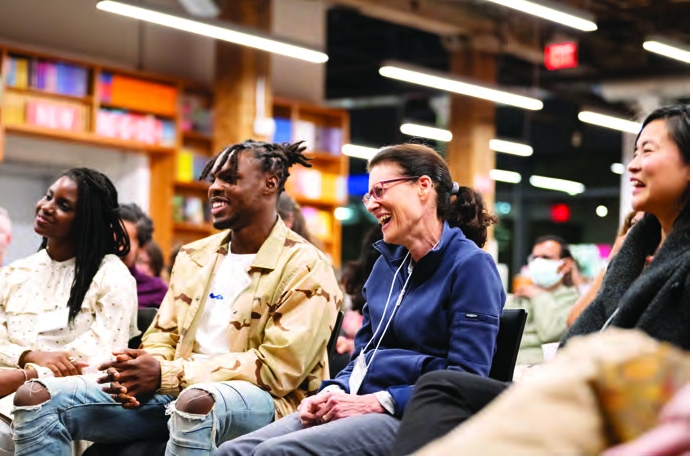
(above) Guests at a past Jar salon. (below) Participants enjoy a comedy performance at a Jar event.

On a crisp spring evening in early May, several dozen people from all ages, backgrounds and walks of life gathered in Simmons Hall, an eye-catching MIT residence hall designed by Steven Holl. Inside the apartment of an MIT professor, the group of strangers observed artworks, ate dinner together and engaged in meaningful discussions about their joys, their conflicts and their traumas.
Despite the venue, this wasn’t a college-organized function. It was a salon-style event hosted by The Jar, an organization designed to foster human connection, diverse environments and equitable access to arts and culture.
Established in 2019, The Jar uses a method called convening to bring people together. Here’s how it works: A convener buys a ticket to a Jar event; the cost is usually $40 for salon events and $60 for performances. This ticket includes four people, the ticket holder, their plusone (a spouse, friend, family member) and two additional guests. The convener is instructed to bring two additional people who look, live or pray differently than them, people they’d perhaps like to get to know better.
“The convener model, in many ways, was a solution to this problem of loneliness, to the problem of segregation, to the problem of a lack of diversity,” says The Jar's founder, Guy Ben-Aharon. “The Jar created a structure for people to create the change that they want themselves.”
At both styles of events — salon and performance — the guests mingle for a bit before experiencing some type of art. It might be a comedy show or a concert performance or a host showcasing a beloved painting. Salons are always hosted by an individual in their home for an especially intimate experience. After experiencing the art, which is something of a facilitator, a cultural common ground for the guests, the crowd rotates in structured groups and responds to openended questions to stimulate personal connection.
There’s something very liberating about discussing big ideas and personal moments, at your own comfort level, with perfect
strangers. The model also facilitates people of all ages, races,
backgrounds and interests meeting each other.
“Just
walking into a diverse room, for me as a woman of color, just walking
in is a treat,” says Samantha Tan, who has been convening with The Jar
since its launch in 2019. “I've been touched and changed by so many
people's stories.”
Boston
doesn’t lack diversity, but it’s notoriously segregated. The Jar
creates rooms that are almost never encountered organically in the city
and they now have the numbers to prove it.
The
Jar worked with a consulting firm to generate a Qualitative Impact
Report, published this year, with hard data about their events. The
results showed that in 2019, white attendees made up 84% of attendance
to arts events in Boston, with only 4% Black attendees, 5% Hispanic or
Latino attendees, and 7% Asian attendees. At The Jar events, only 38% of
attendees are white, while 12% are Black, 12% are Hispanic or Latino,
and 22% are Asian.
The
trend of diverse rooms continues in the data across faiths, ages, years
lived in Boston, queer- and disabled-identifying individuals and other
factors.
Whereas arts
spaces in the city generally only represent a small part of the
population, The Jar events show a much wider, more accurate picture of
who lives here.
Part
of the data-gathering process included getting feedback from people who
have participated in The Jar. Ben- Aharon recalls a particularly
memorable story about a Jar convener who recently had a birthday brunch
and every guest was someone he had met at a Jar event, an illustration
of long-lasting connections made.
With
data backing up the success of their approach, the team at The Jar
hopes to entice even more Boston locals to experience their events and
meet new people. As the organization continues to grow, the model could
be used for any number of diversification and inclusivity efforts, but
for now it’s still about Bostonians connecting with each other.
“Unlike
many other initiatives that dictate what happens in the room, The Jar
is really rooted in the kindness of people and the generosity of people
who go out on a limb and develop a new practice in their life to
comfortably be with people who they already know, and maybe a little
uncomfortably be with people they don’t know,” says Ben- Aharon. “If you
want an excuse to get to know new friends, this is the place for you.”
ON THE WEB
Learn more at jumpinthejar.org